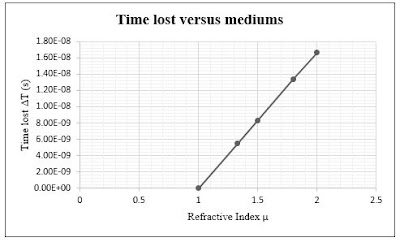TIME LOST BY LIGHT IN DIFFERENT MEDIUMS
INTRODUCTION
Light is an
electromagnetic wave. It travels with a constant speed of 3 x 108
m/s or 186000 miles/s in vacuum. It is also known as the cosmic constant c. But
as the medium changes, the speed of light also changes. When light enters a
medium, it undergoes refraction. Refraction is a phenomenon of bending of
light. All mediums have a unique value of refractive index μ. Light still
continues to move at c but it since it has to move through all the atoms of the
corresponding medium, its speed is reduced by a factor of μ of the medium. All
of the known mediums like water, glass, oil have μ greater than that of vacuum.
For vacuum μ = 1. Thus light travels slowly in all mediums with respect to
vacuum. We intend to determine the time lost by light in various mediums with
respect to vacuum.
CALCULATION
The general equation for time lost by light is,
DT = (x/c)*[m -
1]
DT - Time
lost by light (s)
x – Distance traveled by light (m)
c – Speed of light in vacuum (m/s)
MEDIUM
1: AIR
[μ = 1.001]
The time lost in air is,
DT1 = (x/c)*[1.001 -
1]
= 0.001[x/c] s
MEDIUM
2: WATER
[μ = 1.33]
The time lost in water is,
DT1 = (x/c)*[1.33 -
1]
= 0.33[x/c] s
MEDIUM
3: GLASS
[μ = 1.5]
The time lost in glass is,
DT1 = (x/c)*[1.5 -
1]
= 0.5[x/c] s
MEDIUM
4: GLASS,
FLINT, 71% LEAD [μ = 1.8]
The time lost in flint glass is,
DT1 = (x/c)*[1.8 -
1]
= 0.8[x/c] s
MEDIUM
5: GLASS,
ARSENIC TRISULFIDE [μ = 2]
The time lost in arsenic trisulfide glass is,
DT1 = (x/c)*[2 -
1]
= [x/c] s
Consider a beam of white light traveling a distance
of x = 5 m through all mediums one at a time. We’ll determine the time lost by
light in every medium and plot a graph of time lost versus medium to determine
the medium where light loses maximum time.
|
Refractive Index [μ]
|
Time lost [s]
|
|
1.001
|
1.67E-11
|
|
1.33
|
5.50E-09
|
|
1.5
|
8.33E-09
|
|
1.8
|
1.33E-08
|
|
2
|
1.67E-08
|
GRAPH
EXPLANATION
We can observe that the graph is linear. It means
that light will lose more time the as the refractive index increases. In this
example light travels for 5 m in different mediums. When light travels through
glass it loses around 8.3 nanosecond relative to vacuum and similarly 5.33
nanosecond in water. The loss will increase linearly with the distance traveled
by light meaning if light were to travel for 1 year or 1 light year, the light
in glass would lose considerable amount of time relative to the light in
vacuum.
CONCLUSION
We thus determined the time lost by light in
different mediums relative to vacuum.

No comments:
Post a Comment